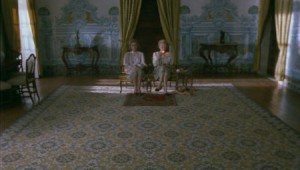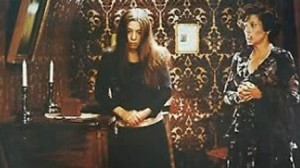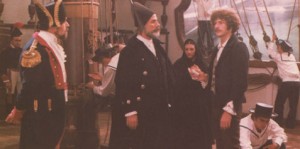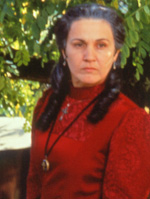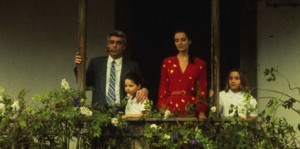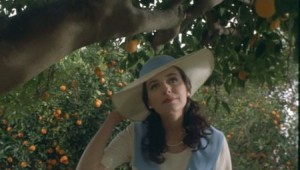From the Chicago Reader (August 25, 1995). — J.R.
Valley of Abraham
*** (A must-see)
Directed and written by Manoel de Oliveira
With Leonor Silveira, Cecile Sanz de Alba, Luis Miguel Cintra, Rui de Carvalho, Luis Lima Barreto, Diogo Doria, Jose Pinto, and Isabel Ruth.
I think the most important intellectual discovery I’ve made in the past year came from the early pages of Eric Hobsbawm’s The Age of Extremes: A History of the World, 1914-1991. In a way, it’s an observation so obvious that I wonder why it never occurred to me before: “Unlike the ‘long 19th century,’ which seemed, and actually was, a period of almost unbroken material, intellectual and moral progress…there has, since 1914, been a marked regression from the standards then regarded as normal in the developed countries and in the milieus of the middle classes and which were confidently believed to be spreading to the more backward regions and the less enlightened strata of the population….Since this century has taught us, and continues to teach us, that human beings can learn to live under the most brutalized and theoretically intolerable conditions, it is not easy to grasp the extent of the, unfortunately accelerating, return to what our 19th century ancestors would have called the standards of barbarism.”
So thoroughly had I been brainwashed by the myth of perpetual progress that it didn’t even occur to me that the history of the 20th century might be one of regression. Indeed, capitalist notions of expanding markets and improving goods and services may now be so firmly entrenched that it’s become all but impossible to weigh such contrary evidence as the greenhouse effect, mass homelessness, and current congressional plans to give the Pentagon $7 billion more than it’s requested while cutting $9 billion from health, labor, and education funding. In effect our society has ruled that anything at all can be blamed for our troubles except capitalist greed and material progress. Add to that the belief that we have far outrun our 19th-century counterparts, and the likelihood of people deciding that the 19th century has something to teach us seems very remote. It’s difficult enough to find out what the 19th century actually was like.
Hobsbawm’s book affords a view of the 20th century framed by the viewpoint of the 19th — the period in which Hobsbawm as a historian clearly feels most at home. The same could perhaps be said of Manoel de Oliveira, probably the oldest filmmaker anywhere still working, whose “difficult” cinema is at once archaic and modernist. Born in 1908 in Porto, Portugal (where many of his films are set), de Oliveira is almost certainly the only living director whose first film was a silent one. One might think that this alone would make him an internationally celebrated figure, especially during this year’s “centennial of movies”; but actually, outside of Portugal, he’s celebrated only in old-fashioned countries like France that value noncommercial art and believe in state funding. (In fact, 1995 isn’t the centennial of movies, it’s the centennial of movie exhibition — which is why, as Jean-Luc Godard has pointed out, all the recent movie-centennial posters show projectors, not cameras. But in the world of movies, as we all know, estimated gross literally precedes existence, not merely essence.)
No movie by de Oliveira has ever been distributed in the United States, and alas, none of what makes him such an extraordinary figure can be assumed to be common knowledge. So the fact that Facets Multimedia is giving Valley of Abraham (1993), the 13th of his 15 features to date, a full week’s run shouldn’t be taken for granted; if you miss this movie now, you won’t be able to catch up with it or any other de Oliveira picture on video in the foreseeable future. It’s neither his worst movie nor his best, in my opinion; but it offers something no other movie in town can even approximate: a precise but complex sense of how the 19th century might look at the 20th (unlike Merchant-Ivory films, which at most give you a 20th-century view of the 19th).
The son of a prominent industrialist — the first Portuguese manufacturer of electric lamps — de Oliveira was an athlete, a prizewinning race driver, and a college dropout who helped run his father’s factories or went into farming when he wasn’t trying to make movies. (The censorship imposed by Antonio de Oliveira Salazar, who ruled from 1932 to 1968, put many obstacles in his way.) De Oliveira’s interest in movies and in the living conditions of the poor came together in his first completed film, a silent documentary called Hard Labor on the River Douro. He finished it when he was 23, though he’d been involved with movies since the age of 19, both as an actor and as an aspiring filmmaker. But apart from making a few minor documentaries and acting in the first Portuguese talkie, he didn’t make any further inroads in movies until his first feature, a 1942 children’s film, Aniki-Bobo. A whopping 21 years later he made his second feature, Act of Spring, a poetic rendering of a passion play. (In between he made two color documentaries.)
Shorts and documentaries followed, but astonishingly de Oliveira’s first full-length fiction feature for adults, The Past and the Present, wasn’t made until he was 63, in 1971. Since then, he’s made a dozen features and more shorts, many of them remarkable: Benilde (1975) and the four-and-a-half-hour Doomed Love (1978), probably his two greatest films; the nearly three-hour Francisca (1981) and the nearly seven-hour The Satin Slipper (1985), which have their champions as well; then My Case (1986), The Cannibals (1988), No or the Vainglory of Command (1990), The Divine Comedy (1991), The Day of Despair (1992), the three-hour Valley of Abraham, The Money Box (1994), and finally The Convent, which premiered at Cannes three months ago (starring John Malkovich and Catherine Deneuve, it’s one of de Oliveira’s wildest, most aggressively modernist works and is scheduled to appear at the New York film festival next month). De Oliveira is a familiar sight at the major European festivals these days, looks a good 10 or 15 years younger than his 87 years, and shows no signs of slowing down. Reportedly his next feature is already in preproduction.
It’s an oversimplification to say that all or even most of de Oliveira’s work hinges on the European aristocracy of the 19th century, but a good deal of it is clearly shaped by upper-class 19th-century lifestyles and the narrative traditions that go with them: leisurely observation and contemplative treatments of drawing-room conversation. Three of de Oliveira’s major works involve the writings or life of Camilo Castelo Branco (1825-1890), widely considered Portugal’s greatest novelist: de Oliveira adapted his most famous novel in Doomed Love, adapted a contemporary novel about Castelo Branco’s unrequited love for an English girl (Francisca), and dramatized on the basis of Castelo Branco’s letters his progressive blindness and eventual suicide (The Day of Despair). If memory serves, The Cannibals is a contemporary opera with a plush 19th-century setting, done in a plush 19th-century style; The Divine Comedy is derived not from Dante but from various characters and themes in Dostoyevsky.
Many of de Oliveira’s features make striking use of impersonal offscreen narrators (Doomed Love has two, one male and one female), and their unhurried, sprawling commentary is perhaps what’s most 19th-century about his work, evoking the narration of Orson Welles in The Magnificent Ambersons, a film (and novel) explicitly concerned with the clashes between 19th- and 20th-century attitudes: “The only public conveyance was a streetcar. A lady could whistle to it from an upstairs window, and the car would halt at once, and wait for her, while she shut the window, put on her hat and coat, went downstairs, found an umbrella, told the ‘girl’ what to have for dinner, and came forth from the house. Too slow for us nowadays, because the faster we’re carried, the less time we have to spare.”
I assume that de Oliveira’s sprawl and slow pace account for the fact that his films haven’t been distributed in the United States. Those qualities are also what I cherish most about them — the fact that they allow me to muse about what I’m listening to and watching, which is almost invariably beautiful. One academic I know who’s written a book about French philosopher Jacques Derrida and works as a stringer for the New York Times saw No or the Vainglory of Command and told me he found de Oliveira impenetrable. If a Times writer considers de Oliveira tougher than Derrida — something that doesn’t correspond at all to my experience — one can rest assured that Michael Medved won’t find his films congenial either.
I won’t deny that Valley of Abraham sometimes sags — the middle hour in particular — but to my taste most current Hollywood movies are much harder to sit through and offer far less to think about. Moreover, de Oliveira’s too hip not to realize what he’s doing to the reflexes of audiences trained on bad commercial movies, the kind that guarantee meaningless movement at all times and at all costs; and he’s too playful not to tweak us about our impatience. At one point in the third hour of Valley of Abraham, during a character’s extended monologue about the decline of Western civilization — and the particular role played in it by the United States — another character suddenly lifts a blissfully purring cat from the heroine’s lap and flings it directly at the camera, as if to wake us all up. It’s a much wittier and more tactile moment than anything in The Usual Suspects; even the camera registers the unholy impact.
Still, de Oliveira isn’t simply trying to reproduce the warp and woof of 19th-century narratives, boring stretches and all. In fact, Valley of Abraham is based on a contemporary novel of the same title by Agustina Bessa-Luis — the same woman who wrote Fanny Owen, the source novel for Francisca. Bessa-Luis’s novel is itself a kind of adaptation of — or, more precisely, reflection on — Flaubert’s Madame Bovary, whose title character has been transposed to a 20th-century upper-class Portuguese setting. De Oliveira himself inspired Bessa-Luis to write the novel by suggesting this transposition to her. Moreover, the film is set in the Douro region and de Oliveira’s hometown of Porto. So Valley of Abraham is not so much a version of Madame Bovary as an appropriation of some of its plot: de Oliveira has eliminated the bourgeois pharmacist villain Homais and superimposed a 19th-century novelistic narration that’s quite different from Flaubert’s.
Like Flaubert’s character (and Cervantes’s Don Quixote before her), de Oliveira’s Ema grows up reading romantic literature. A beauty capable of causing car accidents by standing on her terrace over a curve in the road, she’s drawn into a loveless marriage to a tolerant doctor named Carlos de Paiva, then takes a long succession of lovers of various ages once she decides that attracting men is her mission in life. The male narrator recounts much of the offscreen action and adds commentary while the camera gazes placidly at Ema in decorous domestic settings or at the breathtaking local scenery: these beautifully framed compositions allow meaning to sink in slowly, as if by osmosis.
“This is a lyrical film,” Oliveira has aptly written. “It is so in the way a woman resists men, who represent power, on the strength of her poetic outlook on the world, even if it is mere illusion….This is the theme of Valley of Abraham: how poetry will lead Ema to her own agony, how she will construct her death on the basis of a poetic view of the world and finally, how she will, step by step, organize such agony poetically.”
Ema de Paiva, c’est moi, de Oliveira seems to be saying. His modernism — the necessary complement to his 19th-century digressiveness — resides partly in the casual disjunctions he creates between words and images, partly in foregrounding the arbitrary nature of the visual representation. Young Ema is played by one actress (Cecile Sanz de Alba), grown Ema by another (Leonor Silveira), and rather than attempt to minimize or rationalize their different appearances, Oliveira rubs our noses in the discrepancy, even to the point of having Silveira twice gaze at a photograph of de Alba as her younger self. The solo piano music that provides the score (apart from a jazz record at a party and a violinist performing Bach) recalls silent-movie accompaniment, though other facets of the film, like the color and the sound effects, make it clear that this is anything but a period piece.
If you’re interested in a pleasant three-hour escape from 20th-century barbarism, I can’t think of a better place to go. “Films, films,” de Oliveira wrote in a “Cinematographic Poem” nine years ago:
The best resemble
Great books
That are difficult to penetrate
Because of their richness and depth….
The cinema isn’t easy
Because life is complicated
And art indefinable
Making life indefinable
And art complicated.
If you agree with these sentiments, you should make tracks to Facets and let Kevin Costner die of green rot.

